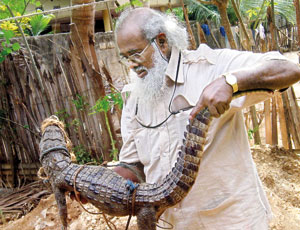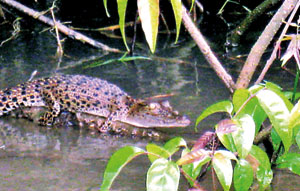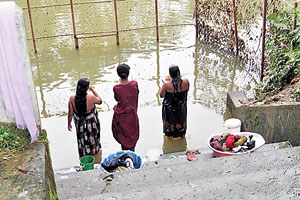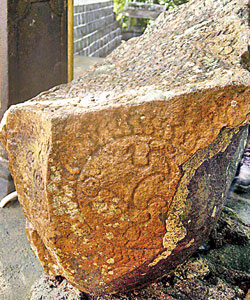Four-legged or no legged, big or small, ambling or slithering, whatever forms the natural dangers took, our ancestors seemed to have known how to deal with them.
Not only did they deal with them effectively, be it elephant, snake or crocodile, they also passed down their knowledge, sometimes ingrained in stone to posterity.
Setting his sights on the much-reviled and maligned crocodile, which are among the few survivors of the dinosaur age, Sri Lanka’s very own ‘Dundee’ has trudged along the banks of rivers on a journey down the misty corridors of time in search of the secrets of our forefathers and the more modern techniques through which the rural folk co-exist with this reptile.
 |
| Mr. de Silva rescued this five-foot Mugger from a fishing net in Jaffna and released it |
After his arduous search across the country, Anslem de Silva, well-known for his work on creatures slimy and slithery, has brought the strange but amazing “traditional methods” that Sri Lankans deploy in the prevention of crocodile attacks to world-focus. This is through a well-researched piece in the latest Crocodile Specialist Group Newsletter out on April 26.
No stranger to crocodiles, Mr. de Silva had observed these creatures (which interestingly have changed little for many million years since the dinosaurs) while still a boy in his hometown of Matara. During this study, he has not only had long chats with village elders, traditional snake-bite physicians, astrologers and boatmen but also traced families affected by crocodile attacks after meticulously clipping and filing news items of such incidents as well as spreading the word that he would like to be told about such incidents.
Two species, the Mugger (Crocodylus palustris) and the Saltwater (C. porosus) crocodiles glide in and out of a variety of habitats such as rivers, streams and wewas (man-made tanks), coming into contact with people who also use these water bodies for drinking, bathing, washing clothes and to earn a living through fishing and harvesting aquatic or semi-aquatic edible and non-edible plants, Mr. de Silva says.
Pointing out that both the Mugger and the Saltwater crocodiles are known to attack humans, livestock and pets such as dogs, he explains that people have resorted to various forms of prevention handed down from their ancestors which include both physical and spiritual.
Titled ‘Prevention of crocodile attacks in Sri Lanka: Some traditional methods’, Mr. de Silva has put the spotlight on them through the newsletter published in Australia but distributed worldwide by the Crocodile Specialist Group of the IUCN – Species Survival Commission.
Delving into spiritual practices including inscribed charms and talismans and protective mantras, this ‘crocodile hunter’ of a different kind has unearthed a granite stone artifact, irregularly hexagonal, around 46 cm in length, width and height, with an intricate talisman engraved on the upper surface, with the charm inscribed on the other four sides.
Although now at the Dutugemunu Temple of the Sandarawela Rathnasara Pirivena, in Ganegama, Baddegama, down south, the stone dating from circa 1469-1474 AD had originally been found in the Gin Ganga at Baddegama, Mr. de Silva’s research, funded by the Mohamed bin Zayed Species Conservation Fund, has revealed.
 |
| Saltwater baby croc hiding in mangrove vegetation |
On his forays into the wild as well as to more inhabited areas where men, women and children come face-to-face with crocodiles, his path had been made smoother by the research already in place of former Professor of History and Archaeology, University of Sri Jayewardenepura, Mendis Rohanadeera and the assistance rendered by former Director (General Services) of the Archaeology Department, M.B. Herath.
The charm written in stone starts with salutations to Lord Buddha and various deities and then invokes protection for all humans from male and female crocodiles, says Mr. de Silva, pointing out that it ends with the disclosure that “...this is the crocodile charm that tied the crocodiles and she crocodiles”. Incidentally, Rohanadeera’s research has suggested that the charm and talisman are the work of scholar-monk Ven. Thotagamuwe Rahula of the 15th Century who gets a mention in history textbooks in schools.
Mr. de Silva has also been told of charmed stones in the Nilwala Ganga, at the main bathing spot in Matara town and at Nadulgala, and in a river at Tissamaharama, but laments that they have not been discovered yet.
From granite stones to mantras, he has uncovered two short ones of four to 10 words recorded in 1954 by Gnanaloka which people were supposed to recite before entering waters inhabited by crocodiles.
“Om Sumas Shri Devane Muka Bandrama,” was an incantation to god Sumas to tie the mouth of the crocodile not to bite, the Sunday Times understands.
Widely known but now extinct in the country, Mr. de Silva recalls just one instance where a police officer of the Mankulam Police Station spoke of a diver from his village of Manampitiya who used charms to protect himself before seeking the bodies of crocodile victims in the Pali Aru and Kidapuchchan kulam.
Looking worldwide, he cites Borneo where crocodile charmers are still popular and our very own ‘shark charmers’ of yore who protected divers harvesting oysters during the British era.
With dengue on the rise and mosquito repellents both local and foreign being sold over the counter, it comes as no surprise that herbal pills had been used in Sri Lanka to repel even bigger creatures.
Bhagawath Jeewara Guliya was the answer for crocodiles, it is learnt, containing plants, seeds and other ingredients but also being prepared under specific conditions and rites governed by auspicious times.
There is a strong belief that crocodile attacks could be kept at bay if the pill mixed with the juice of the kotakimbula plant (Ficus hispida) is put into a river or tank infested with crocodiles, Mr. de Silva’s research has found.
The toxic effects of various plants such as the unripe fruit of kukuruman (Randia dumetorum) are used by villagers to catch fish, although this practice is prohibited by law, he states, explaining that in Kalkudah people make a paste of unripe kukuruman to poison fish.
Have you heard of kimbul kotu, asks this crocodile expert, who along with his team studied 70 of these crocodile exclusion enclosures, both abandoned and in use, along the Nilwala Ganga from Modara to Paraduwa in Matara. Interesting details emerge of these “physical barriers” against crocs.
 |
| Communal crocodile exclusion enclosure |
They could be small enclosures (about 3X3m) erected by individual families for bathing and washing clothes and utensils or large enclosures by a pradeshiya sabha or urban council for communal use.
A large enclosure opposite Matara town used by many people for several decades had been washed away by the 2004 tsunami but not re-erected, says Mr. de Silva who as a boy had bathed there in the mid-1950s.
Traditional enclosures are constructed of thick kitul palm (Caryota urens) planks or long hardwood poles driven firmly into the riverbed, the two ends of the enclosure abutting the banks while those with metal rods and wire have come in more recent times. Traditional and metal enclosures have fencing only on three sides, it is learnt.
All crocodile attacks that occurred during the research period involved people bathing, washing clothes or fishing outside an enclosure or in areas sans one, stressed Mr. de Silva.
Meanwhile, he says that sometimes, crocodiles stray into domestic compounds at night, to prey on pets or poultry and this has led to the construction of metal exclusion fences.
People’s negligence led to attacks
Let them live, is conservationist and current Vice Chairman of the Crocodile Specialist Group, IUCN for South Asia and Iran, Anslem de Silva’s plea to Sri Lankans, not only because he has found that almost all crocodile attacks were due to the negligence of people but also as these reptiles are of vital importance for the ecosystem and thus to the survival of humans. “They are a relic from the past and should be safeguarded. Crocodiles in fact saw the extinction of the dinosaurs.”
The victims were aware of the presence of crocs in the water where they were attacked in 90% of the 131 cases examined (interviewed) by Mr. de Silva during his human-crocodile conflict study. “People from the wet zone hill country, who recently settled in the dry zone under the Accelerated Mahaweli Project were initially ignorant of crocodile habits and as such vulnerable, with dry zone tanks being the main Mugger habitats,” he says.
 |
| The crocodile charm |
Based on the accounts of attack victims and witnesses, the Sunday Times understands that the crocodiles had observed people engaged in water-based activities over a period of time before attacking them.
“This would imply that some attacks were not the result of a casual encounter with potential prey, but reflected direct hunting,” stresses Mr. de Silva.
Words of wisdom and guidance on how the authorities, the government and the local authorities, could protect people from the jaws of crocodiles come from this expert:
- Make vulnerable populations aware of the dangers posed by crocodiles
- Instal and maintain physical protective structures such as crocodile exclusion enclosures and fences leaving adequate space along the bank for the crocodiles to roam at night
- Put up large warning signs in danger areas
- When resettling people in areas where there are crocodiles the community should be advised on the safety measures that need to be taken
- The role of NGOs should not be ignored as recently the World Wildlife Fund/American Red Cross Partnership installed a few ‘crocodile-fences’ along the Nilwala Ganga in Matara (on Mr. de Silva’s recommendations)
- Herbal and chemical crocodile repellents should be investigated, taking into consideration the adverse or toxic effects which could endanger other aquatic fauna, flora or render the water unfit for human use
|





